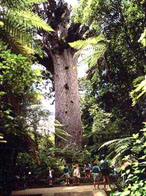
Tane Mahuta, claimed to be the largest living kauri, in Waipoua Forest Sanctuary (2). |
Agathis australis (Lamb.) Steud.
Common NamesNew Zealand kauri (1).Taxonomic notesSyn: Dammara australis Lamb. (7).DescriptionA narrowly conical tree 40-50 m tall and 3-10 m or more in girth, becoming flat-topped with age. Trunk remarkably cylindrical. Bark ash-grey, mottled purple, in large thick plates. Branches in whorls or irregularly horizontal. Branchlets smooth, glaucous. Buds rounded, with imbricate scales. Juvenile leaves glaucous-green, 5-10 cm long. Adult leaves ovate-lanceolate, 1.5-6 cm long by 10-15 mm wide, green, slightly glaucous beneath near the petiole, obtuse, with 15 parallel nerves and a short petiole. Usually monoecious. Male cones cylindrical, 3-6 cm long by 1 cm wide, on a stout peduncle 1 mm wide; sporophylls imbricate, margin weakly erose. Female cone subglobose, on a short peduncle, 6 cm long by 6-8 cm wide, glaucous-green, scales 1.8 cm long with a short mucronate umbo (1). The reproductive cycle extends over 19-20 months from pollination in October to seed maturity in February or March of the second year following (10).RangeNew Zealand: N peninsula of N Island, at low elevations (1). Lives in a forest which includes Podocarpus totara, Dacrydium cupressinum, and Podocarpus ferruginoides.Big TreeTane Mahuta (Maori for 'Lord of the Forest'), in Waipoua Forest Sanctuary, pictured here, is commonly claimed to be the largest. It is 40 m tall and 521 cm dbh. A tree in the Coromandel Range is 56.4 m tall, and another tree in Waipoua Forest Sanctuary is 51.5 m tall and 439 cm dbh (8).OldestAbout 1000 years. Te Matua Ngahere (Father of the Forest) in Waipoua Forest is claimed, apparently on the basis of no real evidence, to be 2000 years old.DendrochronologyDendrochronologically usable, known to exceed 1000 years. Research is summarized by Palmer, Ogden and Norton (3, 4) and has included population age structure work as well as climate reconstruction (e.g., 5, 6).EthnobotanyFormerly an important timber source, now largely exterminated or protected. As with other species of Agathis, it produces a copal or resin, and subfossil fragments of this resin are gathered and polished with rather lovely results. Details are available at the website for The Kauri Museum, in Kauri country (northern North Island).ObservationsIt is commonly seen at the Waipoua Forest Preserve, where thousands of tourists annually visit Tane Mahuta (pictured here).Remarks"Abundant sub-fossil wood of kauri Agathis australis (Salisb.) is preserved in peat swamps throughout the present distribution of the species in North Island, New Zealand. Analysis of 107 radiocarbon dates on this material shows they fall mainly into two groups. A northern group represents late Pleistocene interstadial forests, while a southern group relates to a mid to late Holocene expansion to the current southern limits of the species at c. 38°S. Wood growth rates in the interstadial samples, compared to modern trees, suggest that kauri was stressed by lower temperatures and a wetter environment. With further temperature reduction in the late Otiran stadial (last glacial maximum) growth may have been limited to c. four summer months. The scarcity of kauri pollen from stratigraphic samples and the rarity of wood dating from this period support the contention that kauri was much reduced in abundance during the last glacial maximum" (9).See also Paleobotany of Australia and New Zealand conifers. Citations(1) Silba 1986.(2) Ian Lightbody. 1996. The Kauri Tree, page on The Kauri Museum website. URL = http://www.hmu.auckland.ac.nz:8001/gilchrist/matakohe/kauritree.html, accessed 9-Feb-2000. (3) Norton & Palmer 1992. (4) Palmer & Ogden 1992. (6) Salinger et al. 1994. (7) Hortus Botanicus Catinensis, http://www.dipbot.unict.it/orto/0016-1.html. (8) Carder 1995. (9) J. Ogden, A. Wilson, C. Hendy and R.M. Newnham. 1992. The Late Quaternary history of kauri (Agathis australis) in New Zealand and its climatic significance. Journal of Biogeography 19(6): 611-622. (10) J.N. Owens, G.L. Catalano, and C.J. Aitken. 1997. The reproductive biology of kauri (Agathis australis). IV. Late embryogeny, histochemistry, cone and seed morphology. International Journal of Plant Sciences 158: 395-407.
See also:
M. Ahmed and J. Ogden. 1987. Population dynamics of the emergent conifer Agathis australis (D. Don) Lindl. (kauri) in New Zealand. I. Population structures and tree growth rates in mature stands. New Zealand Journal of Botany 25(2):217-229. M.C. Bridge and J. Ogden. 1986. A sub-fossil kauri (Agathis australis ) tree-ring chronology. Journal of the Royal Society of New Zealand 16(1):17-23.
C.E. Ecroyd. 1982. Biological flora of New Zealand 8.
Agathis australis (D. Don) Lindl. (Araucariaceae) Kauri.
New Zealand Journal of Botany 20:17-36.
N.J. Enright, R.M. Bartlett and C.R. De-Freitas. 1993. Patterns of species composition, recruitment, and growth within canopy gaps in two New Zealand kauri (Agathis australis) forests. New Zealand Journal of Botany 31(4):361-373. N.D. Mitchell. 1991. The derivation of climate surfaces for New Zealand, and their application to the bioclimatic analysis of the distribution of kauri (Agathis australis). Journal of the Royal Society of New Zealand 21(1):13-24. J. Ogden, G.M. Wardle and M. Ahmed. 1987. Population dynamics of the emergent conifer Agathis australis (D. Don) Lindl. (kauri) in New Zealand. II. Seedling population sizes and gap-phase regeneration. New Zealand Journal of Botany 25(2):231-242. Owens, John N., Glenda L. Catalano and Jenny Aitken Christie. 1997. The reproductive biology of kauri (Agathis australis). IV. Late embryogeny, histochemistry, cone and seed morphology. International journal of plant sciences 158(4):395. (Parts I, II, III also published). |
|
back | Agathis | Araucariaceae | home
This page is from the Gymnosperm Database
|